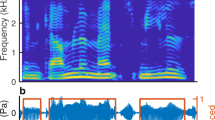Summary
Correlations were made between speech discrimination scores, pure-tone thresholds, and neuronal populations in 28 cochleae which were removed postmortem from elderly patients who had known premortem audiometric records. The predominant pathology present was loss of cochlear neurons. The capability for speech discrimination correlated directly with the innervation density of the 15- to 22-mm region (segment III) of the cochlea. Speech discrimination scores showed an inverse relationship to pure-tone thresholds in the middle frequency range of 1 kHz to 2 kHz.
Similar content being viewed by others
References
American Speech and Hearing Association (1978) Guidelines for manual pure-tone threshold audiometry. American Speech and Hearing Association, Washington, DC, pp 297–301
Carhart R, Jerger J (1959) Preferred method for clinical determination of pure-tone thresholds. J Speech Hear Disord 24:330–345
Guild SR (1921) A graphic reconstruction method for the study of the organ of Corti. Anat Rec 22:141–157
Keithley EM, Feldman ML (1979) Spiral ganglion cell counts in an age-graded series of rat cochleas. J Comp Neurol 188:429–442
Kimura RS, Ota CY, Takahashi T (1979) Nerve fiber synapses on spiral ganglion cells in the human cochlea. Ann Otol Rhinol Laryngol [Suppl 62] 88:1–17
Koenig W (1949) A new frequency scale for acoustic measurements. Bell Laboratories Record, p 209
Nadol JB (1979) Electron microscopic findings in presbycusic degeneration of the basal turn of the human cochlea. Otolaryngol Head Neck Surg 87:818–836
Otte J, Schuknecht HF, Kerr AG (1978) Ganglion cell populations in normal and pathological human cochleae. Implications for cochlear implantation. Laryngoscope 88:1231–1246
Schuknecht HF (1953) Techniques for study of cochlear function and pathology in experimental animals: development of the anatomical frequency scale for the cat. Arch Otolaryngol 58:377–397
Spoendlin H (1969) Innervation patterns in the organ of Corti of the cat. Acta Otolaryngol (Stockh) 67:239
Spoendlin H (1971) Degeneration behavior of the cochlear nerve. Arch Klin Exp Ohren-Nasen-Kehlkopfheilkd 200:275
Spoendlin H (1975) Retrograde degeneration of the cochlear nerve. Acta Otolaryngol (Stockh) 79:266–275
Spoendlin H (1979) Neural connections of the outer hair cell system. Acta Otolaryngol (Stockh) 87:381–387
Spoendlin H (1981) Differentiation of cochlear afferent neurons. Acta Otolaryngol (Stockh) 91:451–456
Author information
Authors and Affiliations
Additional information
Supported by the National Institute of Neurlogical and Communicative Disorders and Stroke, grant no. 5 ROI NS05881
Rights and permissions
About this article
Cite this article
Pauler, M., Schuknecht, H.F. & Thornton, A.R. Correlative studies of cochlear neuronal loss with speech discrimination and pure-tone thresholds. Arch Otorhinolaryngol 243, 200–206 (1986). https://doi.org/10.1007/BF00470622
Received:
Accepted:
Issue Date:
DOI: https://doi.org/10.1007/BF00470622




